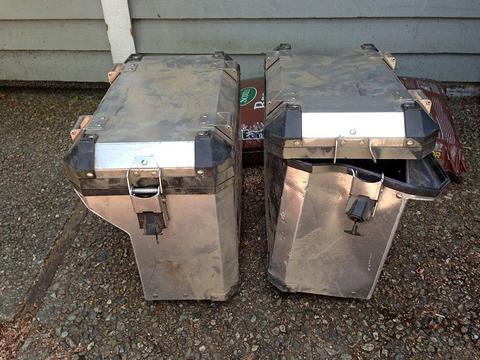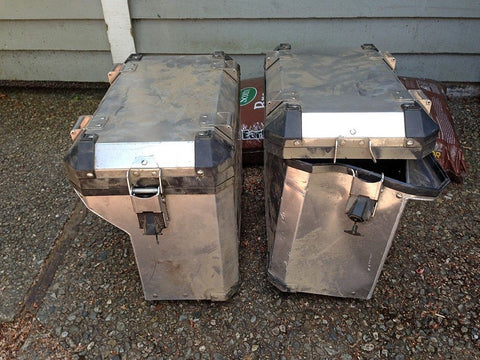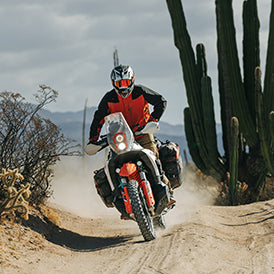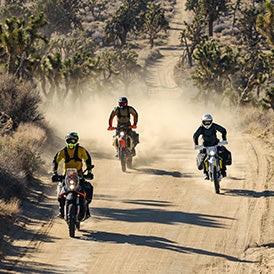Your Cart is Empty
Luggage
Apparel
events
The Mosko Blog
Soft Luggage vs Hard Luggage
April 12, 2022

We’ve used both soft and hard luggage on countless trips here in the U.S., and also riding internationally in places like Africa, Asia, and South America. We’ve used both types of systems on pavement and in the backcountry, and trashed both types in crashes and slides.
There is no ‘right answer’ in the hard vs soft debate. Hard panniers are good for some things, soft panniers are good for others. For extended multi-day trips mostly on dirt, soft luggage is the obvious choice. For work commuting or inner-city riding, hard luggage might be better. That said, lots of riders use soft luggage in the city and others use hard luggage on dirt.
Adventure soft luggage has come a long way from the basic sewn-seam, over-the-seat saddlebags that dualsporters were using for offroad camping 10-20 years ago. First, the introduction of ‘rackless’ bags (like the Reckless 80) enabled riders to ditch their pannier racks entirely, eliminating weight and cost while still maintaining a firm connection to the bike. Then, for long-distance touring, frame-panniers (like the Backcountry 35) combined some qualities of hard luggage with some qualities of soft luggage, creating an ideal solution for long-term, long-distance travel.

Mosko Moto Reckless 80 Harness
One of the primary reasons people switch to soft luggage, is that they get tired of trashing a set of hard bags when they ride offroad. Hard bags tend to break off the bike and/or dent when the bike hits the ground. Once the latches, mounts, and/or seals are damaged, the bags never recover, and they’re expensive to replace. If you’re on a long trip, that can be very inconvenient. Soft luggage is a lot more resilient, and will stay waterproof through many offroad crashes.

Hard Boxes, Offroad Crash, Washington State, July 2014, Thanks Lacey!
Another reason is safety. Soft luggage is indisputably safer for offroad riding. People come up to our booth at every show with stories of broken legs and ligaments. The story is always the same, it goes something like this:
“I was riding offroad and we hit a section of sand/mud/rocks. I put a foot down for stability, but something went wrong, and it got stuck there for a second. The leading edge of my metal pannier slammed into the back of my leg, trapping it between the ground and the pannier, and snapping my ankle/tibia/fibula/ligament.”
If you browse online forums like ADVrider.com and Horizons Unlimited, or talk to other riders at rallies, you will hear this story again and again. Check out this thread: Hard Panniers & Broken Legs: Myth or Reality. Soft panniers are smaller and more tapered than hard panniers, and they have enough ‘give’ under pressure to prevent injuries. Which is not to say that you won’t break a leg with soft luggage: that can still happen. It’s just a lot less likely.


"We were in a deep, sandy two track. It just wasn´t wide enough to maneuver as much as I needed. The bike flopped over on its ride side, my foot got peeled off the footpeg, and the sidecase and my leg tried to share the same space at the same time." Bryan, BMW R1200GS & Hard Luggage
Here are a few other benefits of soft luggage for adventure touring:
- More Features: Working with fabric, designers can introduce built-in features that wouldn’t be possible with metal. Soft bags have internal & external pockets, water-storage solutions, MOLLE expansion capabilities, backpack straps, beavertail stash spots, and more. These features are an integral part of modern backpacking gear, and they’re equally handy for moto camping.
- Lower Cost: Dollar for dollar, you get a lot more from soft luggage in terms of durability, features, and weight-savings. In some cases you can buy an entire soft luggage kit for the price of replacing a single mashed-up hard box. Some riders keep one set of each, using hard boxes for commuting and soft bags for camping offroad.
- Lower Weight: A 35L frame-mounted soft pannier should weigh roughly 25-50% less than a fully featured equivalent hard box. 5-10 pounds may not seem like much of a difference on a big adventure bike with adjustable preload, but on a smaller bike 5-10 pounds is huge. To really save on weight, skip the pannier racks and go rackless (like the Reckless 80.)
When evaluating soft luggage, keep in mind that there are several different kinds of soft luggage, each with their own merits in terms of cost, convenience, weight, and durability:
- Frame-Panniers: Frame-Panniers (like the Backcountry 35) have a hard frame on the back of the bag. They’re extremely easy to mount/dismount, and they don’t flop around while riding. They’re also the most durable soft bags on the market.

- Saddlebag Panniers: Saddlebag panniers connect over the seat, and also to the rack, with straps. The main advantage of saddlebags is that they’re cheap. However, they’re also a hassle to mount, they distort under load, and they move around a lot in bumpy terrain. (This is a generic pic borrowed from a factory on alibaba.com, we don't make - or use - saddlebags, so we don't have any pics)

- Rackless Panniers: Rackless panniers (like the Reckless 80) win on weight and price, because you don’t need metal racks to support them. Reducing weight is especially important on smaller bikes, and for riders who like to pack light & tight and ride aggressively.

Much is made of the perceived security benefits of hard luggage vs soft luggage. A locked aluminum hard pannier certainly ‘looks’ harder to steal than a similarly locked soft pannier. However, pretty much all modern soft luggage offers a locking feature (like the Steelcore Locking Strap), so the difference between the two is negligible. A determined thief with the right tools and enough time will eventually get into anything. So pick the luggage you want, lock it up, and try not to worry too much.

Steelcore Locking Strap
Choosing the right luggage system between hard and soft panniers is a totally personal decision. If you’re riding pavement in an urban environment, where the odds of crashing are low and the risk of theft is high, then hard boxes are probably best. If you’re riding lots of dirt, and searching for increasingly challenging offroad terrain where you’re likely to drop your bike, then a good set of soft luggage would be a wise investment.
And remember, many riders have both.
Braaap,
Pete
Leave a comment
Comments will be approved before showing up.
Warranty and Crash Replacement
We never cut corners during development or manufacturing, so we stand behind our products. If one fails due to a problem with materials or workmanship, we’ll make it right.
Your are successfully subscribed for email notifications.
Notify me when available
We will send you a notification as soon as this product is available again.
Your email is required
We don't share your email with anybody
x








